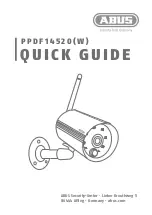
Point Grey Flea3 GigE Technical Reference
8 Flea3 GigE Attributes
Interpreting ROI information
The first two bytes are the distance from the left frame border that the region of interest (ROI) is shifted. The next two
bytes are the distance from the top frame border that the ROI is shifted.
8.17 White Balance
White balance is applicable to color models only.
The Flea3 GigE supports white balance adjustment, which is a system of color correction to account for differing lighting
conditions. Adjusting white balance by modifying the relative gain of R, G and B in an image enables white areas to look
"whiter". Taking some subset of the target image and looking at the relative red to green and blue to green response,
the objective is to scale the red and blue channels so that the response is 1:1:1.
The user can adjust the red and blue values. Both values specify relative gain, with a value that is half the maximum
value being a relative gain of zero.
White Balance has two states:
State
Description
Off
The same gain is applied to all pixels in the Bayer tiling.
On/Manual
The Red value is applied to the red pixels of the Bayer tiling and the Blue value is applied to the blue
pixels of the Bayer tiling.
The following table illustrates the default gain settings for most cameras.
Red
Blue
Black and White
32
32
Color
1023
1023
The camera can also implement Automatic and One Push white balance. One use of Automatic and One Push white
balance is to obtain a similar color balance between cameras that are slightly different from each other. In theory, if
different cameras are pointed at the same scene, using Automatic and One Push results in a similar color balance
between the cameras.
One Push only attempts to automatically adjust white balance for a set period of time before stopping. It uses a “white
detection” algorithm that looks for “whitish” pixels in the raw Bayer image data. One Push adjusts the white balance for
a specific number of iterations; if it cannot locate any whitish pixels, it will gradually look at the whitest objects in the
scene and try to work off them. It will continue this until has completed its finite set of iterations.
Automatic is continually adjusting white balance. It differs from One Push in that it works almost solely off the whitest
objects in the scene.
The white balance of the camera before using Automatic and One Push must
already be relatively close; that is, if Red is set to 0 and Blue is at maximum (two
extremes), Automatic and One Push will not function as expected. However, if the
camera is already close to being color balanced, then Automatic and One Push will
function properly.
Revised 10/29/2013
Copyright ©2010-2013 Point Grey Research Inc.
79
















































